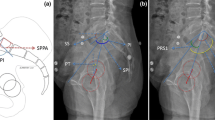Abstract
Purpose
Pelvic incidence (PI), pelvic tilt (PT) and sacral slope (SS) are important parameters in sagittal spine alignment evaluation. The measurements are a projection of the three-dimensional pelvis onto a two-dimensional radiograph and they may be influenced by orientation of the pelvis. The aim of this study was to assess the influence of pelvic rotation in the coronal plane (CPR) on radiographic accuracy of PI, PT, and SS measurements.
Methods
Radiological evaluation of the CPR angel was performed on 1 radiological phantom. The radiographs were taken in 5° CPR increments over a range of 0°–45° (evaluated with a digital protractor). On each of the lateral radiograph, PI, PT, and SS were measured three times by three independent researchers. The lowest CPR that changed PI, PT, or SS by ≥6° (the highest reported error of measurement of these parameters) was considered as unacceptable. Next, CPR was calculated based on the distance between femoral heads (FHD). The agreement of the calculated and measured CPR was quantified by the intraclass correlation coefficient (ICC) and the median error for a single measurement (SEM), with value 0.75 considered as excellent agreement.
Results
PI, PT and SS could be measured with an acceptable error of 6° on radiographs with up to 20° pelvic rotation. From 20° CPR onwards the S1 endplate was distorted, that makes the measurements of PI, PT and SS questionable. There was an excellent agreement between CPR measured with a protractor and calculated based on FHD with ICC of 0.99 and SEM of 1.1°.
Conclusions
Rotation of the pelvis in the coronal plane during acquisition of radiographs influences PI, PT and SS measurements. Substantial error of PI, PT and SS measurements occurs with CPR of more than 20° which is equivalent to a lower limb discrepancy of 5.2 cm. CPR may be calculated while acquiring the radiograph. Further evaluation of the influence of CPR on spinopelvic parameters with a larger sample would be valuable.





Similar content being viewed by others
References
Mehta VA, Amin A, Omeis I, Gokaslan ZL, Gottfried ON (2012) Implications of spinopelvic alignment for the spine surgeon. Neurosurgery 70:707–721. doi:10.1227/NEU.0b013e31823262ea
Lazennec JY, Ramare S, Arafati N, Laudet CG, Gorin M, Roger B, Hansen S, Saillant G, Maurs L, Trabelsi R (2000) Sagittal alignment in lumbosacral fusion: relations between radiological parameters and pain. Eur Spine J 9:47–55
Glassman SD, Berven S, Bridwell K, Horton W, Dimar JR (2005) Correlation of radiographic parameters and clinical symptoms in adult scoliosis. Spine 30:682–688
Vrtovec T, Janssen MM, Likar B, Castelein RM, Viergever MA, Pernus F (2012) A review of methods for evaluating the quantitative parameters of sagittal pelvic alignment. Spine J 12:433–446. doi:10.1016/j.spinee.2012.02.013
Duval-Beaupere G, Schmidt C, Cosson P (1992) A barycentremetric study of the sagittal shape of spine and pelvis: the conditions required for an economic standing position. Ann Biomed Eng 20:451–462
Marty C, Boisaubert B, Descamps H, Montigny JP, Hecquet J, Legaye J, Duval-Beaupere G (2002) The sagittal anatomy of the sacrum among young adults, infants, and spondylolisthesis patients. Eur Spine J 11:119–125. doi:10.1007/s00586-001-0349-7
Mangione P, Gomez D, Senegas J (1997) Study of the course of the incidence angle during growth. Eur Spine J 6:163–167
Legaye J, Duval-Beaupere G, Hecquet J, Marty C (1998) Pelvic incidence: a fundamental pelvic parameter for three-dimensional regulation of spinal sagittal curves. Eur Spine J 7:99–103
Tyrakowski M, Wojtera-Tyrakowska D, Siemionow K (2014) Influence of pelvic rotation on pelvic incidence, pelvic tilt, and sacral slope. Spine 39:E1276–E1283. doi:10.1097/BRS.0000000000000532
Tyrakowski M, Yu H, Siemionow K (2014) Pelvic incidence and pelvic tilt measurements using femoral heads or acetabular domes to identify centers of the hips: comparison of two methods. Eur Spine J. doi:10.1007/s00586-014-3739-3
Shrout PE, Fleiss JL (1979) Intraclass correlations: uses in assessing rater reliability. Psychol Bull 86(2):420–428
Streiner DLNG (2008) Health measurement scales—a practical guide to their development and use, 4th edn. Oxford University Press, Oxford, New York
Jackson RP, Peterson MD, McManus AC, Hales C (1998) Compensatory spinopelvic balance over the hip axis and better reliability in measuring lordosis to the pelvic radius on standing lateral radiographs of adult volunteers and patients. Spine 23:1750–1767
Winter RB, Pinto WC (1986) Pelvic obliquity. Its causes and its treatment. Spine 11:225–234
Brady RJ, Dean JB, Skinner TM, Gross MT (2003) Limb length inequality: clinical implications for assessment and intervention. J Orthop Sports Phys Ther 33:221–234. doi:10.2519/jospt.2003.33.5.221
Nissinen M, Heliovaara M, Tallroth K, Poussa M (1989) Trunk asymmetry and scoliosis, anthropometric measurements in prepuberal school children. Acta Paediatr Scand 78:747–753
Drnach M, Kreger A, Corliss C, Kocher D (2012) Limb length discrepancies among 8- to 12-year-old children who are developing typically. Pediatr Phys Ther 24:334–337. doi:10.1097/PEP.0b013e3182691c48
Mullaji A, Shetty GM, Kanna R, Sharma A (2010) Variability in the range of inter-anterior superior iliac spine distance and its correlation with femoral head centre. A prospective computed tomography study of 200 adults. Skeletal Radiol 39:363–368. doi:10.1007/s00256-009-0791-x
Wade R, Yang H, McKenna C, Faria R, Gummerson N, Woolacott N (2013) A systematic review of the clinical effectiveness of EOS 2D/3D X-ray imaging system. Eur Spine J 22:296–304. doi:10.1007/s00586-012-2469-7
Author information
Authors and Affiliations
Corresponding author
Ethics declarations
Conflict of interest
None.
Rights and permissions
About this article
Cite this article
Janusz, P., Tyrakowski, M., Monsef, J.B. et al. Influence of lower limbs discrepancy and pelvic coronal rotation on pelvic incidence, pelvic tilt and sacral slope. Eur Spine J 25, 3622–3629 (2016). https://doi.org/10.1007/s00586-016-4458-8
Received:
Revised:
Accepted:
Published:
Issue Date:
DOI: https://doi.org/10.1007/s00586-016-4458-8




